The document discusses the problem of determining the optimal way to fully parenthesize the product of a chain of matrices to minimize the number of scalar multiplications. It presents a dynamic programming approach to solve this problem in four steps: 1) characterize the structure of an optimal solution, 2) recursively define the cost of an optimal solution, 3) compute the costs using tables, 4) construct the optimal solution from the tables. An example is provided to illustrate computing the costs table and finding the optimal parenthesization of a chain of 6 matrices.

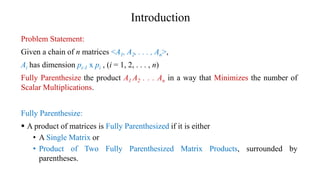
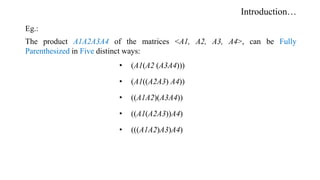
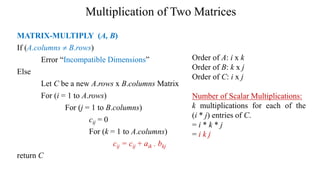
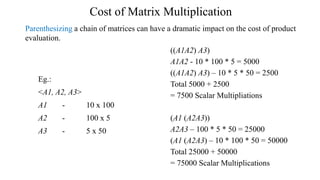
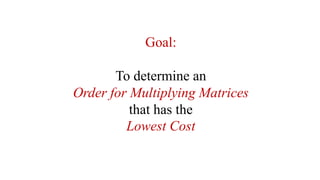
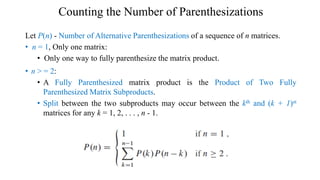

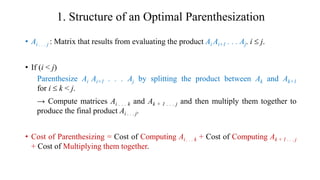
![• Cost of an optimal solution is defined recursively in terms of optimal solutions to
sub-problems.
• Sub-problems: Problems of determining the minimum cost of parenthesizing
Ai A i + 1 . . . A j for 1 i j n.
• m [i, j]: Minimum number of scalar multiplications to compute matrix Ai . . . j
if (i = j)
There is only one matrix A i . . . i = A 1
m [i, j] = 0
If (i < j)
m [i, j] = Cost of Computing Ai . . . k + Cost of Computing Ak + 1 . . . j +
Cost of Multiplying them together.
m [i, j] = m [i, k] + m [k + 1, j] + pi – 1 pk pj
2. A Recursive solution](https://image.slidesharecdn.com/matrixchainmultiplication-200422160133/85/Matrix-chain-multiplication-10-320.jpg)
![ k varies from i to j – 1. Hence,
• s [i, j]: Value of k at which the Split is an Optimal Parenthesization.
A Recursive Solution…](https://image.slidesharecdn.com/matrixchainmultiplication-200422160133/85/Matrix-chain-multiplication-11-320.jpg)
![• pi – 1 x pi - Dimension of matrix A i. i = 1, 2, . . . , n
• p = < p0 , p1 , . . . pn> - List of Matrix Dimensions.
• m [1 . . n, 1 . . n] - Table storing the Costs m [i, j]
• s [1 . . n - 1, 2 . . n] - Table storing the Index of k that achieved
optimal cost in computing m [i, j].
Used to construct an optimal solution.
• m [1, n] - Lowest cost to compute A 1 . . n
3. Computing the Optimal Costs](https://image.slidesharecdn.com/matrixchainmultiplication-200422160133/85/Matrix-chain-multiplication-12-320.jpg)
![MATRIX-CHAIN-ORDER (p)
n = p.length - 1
let m [1 . . n, 1 . . n] and s [1 . . n - 1, 2 . . n] be new tables
For (i = 1 to n)
m [i, i] = 0
For (l = 2 to n)
For (i = 1 to n - l + 1)
j = i + l – 1
m [i, j] =
For (k = i to j – 1)
q = m [i, k] + m [k + 1, j] + pi-1 pk pj
If (q < m [i, j])
m [i, j] = q
s [i, j] = k
return m and s
Computing the Optimal Costs…
Running Time : O (n3)
Space to store Tables m and s : O (n2)](https://image.slidesharecdn.com/matrixchainmultiplication-200422160133/85/Matrix-chain-multiplication-13-320.jpg)
![Example
n = 6
pi = 30, 35, 15, 5, 10, 20, 25
Table m:
• Order: n x n
• i - rows and j - columns
• Only the lower half of the
table upto (i, i) gets filled
because 1 i j n
Matrix A1 A2 A3 A4 A5 A6
Dimension 30 x 35 35 x 15 15 x 5 5 x 10 10 x 20 20 x 25
1 2 3 4 5 6
1 0
2 0
3 0
4 0
5 0
6 0
If no. of matrices = 1, No. of ways to
parenthesize = 0. i.e., m (i, i) = 0
m [1, 1] = 0, m [2, 2] = 0, m [3, 3] = 0
m [4, 4] = 0, m [5, 5] = 0, m [6, 6] = 0
j
i
Tablem](https://image.slidesharecdn.com/matrixchainmultiplication-200422160133/85/Matrix-chain-multiplication-14-320.jpg)
![Example…
• l = 2 → 2 Matrices
• Matrices: A1 A2, A2 A3, A3 A4, A4 A5, A5 A6
• No. of positions where split can occur = 1. Therefore, k = 1, 2, 3, 4, 5
respectively.
• Number of different parenthesizations:
A1 A2: m [1, 2] = m [1, 1] + m [2, 2] + p0 p1 p2 = 0 + 0 + 30 x 35 x 15 = 15,750
s [1, 2] = 1
A2 A3: m [2, 3] = m [2, 2] + m [3, 3] + p1 p2 p3 = 0 + 0 + 35 x 15 x 05 = 2,625
s [2, 3] = 2
A3 A4: m [3, 4] = m [3, 3] + m [4, 4] + p2 p3 p4 = 0 + 0 + 15 x 05 x 10 = 750
s [2, 3] = 3
A4 A5: m [4, 5] = m [4, 4] + m [5, 5] + p3 p4 p5 = 0 + 0 + 30 x 35 x 15 = 1,000
s [1, 2] = 4
A5 A6: m [5, 6] = m [5, 5] + m [6, 6] + p4 p5 p6 = 0 + 0 + 10 x 20 x 25 = 5,000
s [1, 2] = 5](https://image.slidesharecdn.com/matrixchainmultiplication-200422160133/85/Matrix-chain-multiplication-15-320.jpg)
![Example…
n = 6; pi = 30, 35, 15, 5, 10, 20, 25; l = 2 i = 1 to n - l + 1; j = i + l – 1; k = i to j – 1
q = m [i, k] + m [k + 1, j] + pi-1 pk pj
i = 1
j = 1+2-1 = 2
i = 2
j = 2+2-1 = 3
i = 3
j = 3+2-1 = 4
k = 1
q = m [1,1] + m [2,2] + p0 p1 p2
= 0 + 0 + 30 x 35 x 15 = 15,750
k = 2
q = m [2,2] + m [3,3] + p1 p2 p3
= 0 + 0 + 35 x 15 x 5 = 2,625
k = 3
q = m [3,3] + m [4,4] + p2 p3 p4
= 0 + 0 + 15 x 5 x 10 = 750
m [1, 2] = 15,750
s [1, 2] = 1
m [2, 3] = 2,625
s [2, 3] = 2
m [3, 4] = 750
s [3, 4] = 3
i = 4
j = 4+2-1 = 5
i = 5
j = 5+2-1 = 6
k = 4
q = m [4,4] + m [5,5] + p3 p4 p5
= 0 + 0 + 30 x 35 x 15 = 1,000
k = 5
q = m [5,5] + m [6,6] + p4 p5 p6
= 0 + 0 + 10 x 20 x 25 = 5,000
m [4, 5] = 1,000
s [4, 5] = 4
m [5, 6] = 5,000
s [5, 6] = 5](https://image.slidesharecdn.com/matrixchainmultiplication-200422160133/85/Matrix-chain-multiplication-16-320.jpg)

![Example…
• l = 3 → 3 Matrices
• Matrices: A1 A2 A3, A2 A3 A4, A3 A4 A5, A4 A5 A6
• No. of positions where split can occur = 2.
Therefore, k = (1, 2), (2, 3) (3, 4), (4, 5) respectively.
• Number of different parenthesizations:
A1 A2 A3 :
m [1, 1] + m [2, 3] + p0 p1 p3 = 0 + 2625 + 30 x 35 x 05 = 7,875
m [1, 2] + m [3, 3] + p0 p2 p3 = 15750 + 0 + 30 x 15 x 05 = 18,000
s [1, 3] = 1
A2 A3 A4 :
m [2, 2] + m [3, 4] + p1 p2 p4 = 0 + 750 + 30 x 15 x 10 = 6,000
m [2, 3] + m [4, 4] + p1 p3 p4 = 2625 + 0 + 35 x 05 x 10 = 4,375
s [2, 4] = 3
m [1, 3] = min
= 4,375m [2, 4] = min
= 7,875](https://image.slidesharecdn.com/matrixchainmultiplication-200422160133/85/Matrix-chain-multiplication-18-320.jpg)
![Example…
A3 A4 A5 :
m [3, 3] + m [4, 5] + p2 p3 p5 = 0 + 1000 + 15 x 05 x 20 = 2,500
m [3, 4] + m [5, 5] + p2 p4 p5 = 750 + 0 + 15 x 10 x 20 = 3,750
s [3, 5] = 3
A4 A5 A6 :
m [4, 4] + m [5, 6] + p3 p4 p6 = 0 + 5000 + 05 x 10 x 25 = 6,250
m [4, 5] + m [6, 6] + p3 p5 p6 = 1000 + 0 + 05 x 20 x 25 = 3,500
s [4, 6] = 5
m [3, 5] = min
= 3,500m [4, 6] = min
= 2,500](https://image.slidesharecdn.com/matrixchainmultiplication-200422160133/85/Matrix-chain-multiplication-19-320.jpg)
![Example…
n = 6; pi = 30, 35, 15, 5, 10, 20, 25; l = 3 i = 1 to n - l + 1; j = i + l – 1; k = i to j – 1
q = m [i, k] + m [k + 1, j] + pi-1 pk pj
i = 1
j = 1+3-1 = 3
i = 2
j = 2+3-1 = 4
k = 1
q=m[1,1]+m[2,3]+ p0 p1 p3
=0+2625+30x35x5
q = 7,875
k = 2
q=m[1,2]+m[3,3]+ p0 p2 p3
=15750+0+30x15x5
q = 18,000
k = 2
q=m[2,2]+m[3,4]+ p1 p2 p4
=0+750+35x15x10
q = 6,000
k = 3
q=m[2,3]+m[4,4]+ p1 p3 p4
=2625+0+35x5x10
q = 4,375
m [1, 3] = min (7875, 18000) = 7,875
s [1, 3] = 1
m [2, 4] = min (6000, 4375) = 4,375
s [2,4] = 3
i = 3
j = 3+3-1 = 5
i = 4
j = 4+3-1 = 6
k = 3
q=m[3,3]+m[4,5]+ p2 p3 p5
=0+1000+15x5x20
q = 2,500
k = 4
q=m[3,4]+m[5,5]+ p2 p4 p5
=750+0+15x10x20
q = 3,750
k = 4
q=m[4,4]+m[5,6]+ p3 p4 p6
=0+5000+5x10x25
q = 6,250
k = 5
q=m[4,5]+m[6,6]+ p3 p5 p6
=1000+0+5x20x25
q = 3,500
m [3, 5] = min (2500, 3750) = 2,500
s [3, 5] = 3
m [4, 6] = min (6250, 3500) = 3,500
s [4, 6] = 5](https://image.slidesharecdn.com/matrixchainmultiplication-200422160133/85/Matrix-chain-multiplication-20-320.jpg)

![Example…
• l = 4 → 4 Matrices
• Matrices: A1 A2 A3 A4, A2 A3 A4 A5, A3 A4 A5 A6
• No. of positions where split can occur = 3.
Therefore, k = (1, 2, 3), (2, 3, 4) (3, 4, 5) respectively.
• Number of different parenthesizations:
A1 A2 A3 A4 :
m [1, 1] + m [2, 4] + p0 p1 p4 = 0 + 4375 + 30 x 35 x 10 = 14,875
m [1, 4] = min m [1, 2] + m [3, 4] + p0 p2 p4 = 15750 + 750 + 30 x 15 x 10 = 21,000 = 9,375
m [1, 3] + m [4, 4] + p0 p3 p4 = 7875 + 0 + 30 x 5 x 10 = 9,375
s [1, 4] = 1](https://image.slidesharecdn.com/matrixchainmultiplication-200422160133/85/Matrix-chain-multiplication-22-320.jpg)
![Example…
A2 A3 A4 A5 :
m [2, 2] + m [3, 5] + p1 p2 p5 = 0 + 2500 + 35 x 15 x 20 = 13,000
m [2, 5] = min m [2, 3] + m [4, 5] + p1 p3 p5 = 2625 + 1000 + 35 x 5 x 20 = 7,125 = 7,125
m [2, 4] + m [5, 5] + p1 p4 p5 = 4375 + 0 + 30 x 10 x 20 = 11,375
s [2, 5] = 3
A3 A4 A5 A6 :
m [3, 3] + m [4, 6] + p2 p3 p6 = 0 + 3500 + 15 x 5 x 25 = 5,375
m [3, 6] = min m [3, 4] + m [5, 6] + p2 p4 p6 = 750 + 3500 + 15 x 10 x 25 = 8,000 = 5,375
m [3, 5] + m [6, 6] + p2 p5 p6 = 2500 + 0 + 15 x 20 x 25 = 10,000
s [3, 6] = 3](https://image.slidesharecdn.com/matrixchainmultiplication-200422160133/85/Matrix-chain-multiplication-23-320.jpg)
![Example…
n = 6; pi = 30, 35, 15, 5, 10, 20, 25; l = 4 i = 1 to n - l + 1; j = i + l – 1; k = i to j – 1
q = m [i, k] + m [k + 1, j] + pi-1 pk pj
i = 1; j = 1+4-1 = 4
k = 1
q=m[1,1]+m[2,4]+ p0 p1 p4
=0+4375+30x35x10 = 14,875
k = 2
q=m[1,2]+m[3,4]+ p0 p2 p4
=15750+750+30x15x10 = 21,000
k = 3
q=m[1,3]+m[4,4]+ p0 p3 p4
=7875+0+30x5x10 = 9,375
m [1, 4] = min (14875, 21000, 9375) = 9,375; s [1, 4] = 3
i = 2; j = 2+4-1 = 5
k = 2
q=m[2,2]+m[3,5]+ p1 p2 p5
=0+2500+35x15x20 = 13,000
k = 3
q=m[2,3]+m[4,5]+ p1 p3 p5
=2625+1000+35x5x20 = 7,125
k = 4
q=m[2,4]+m[5,5]+ p1 p4 p5
=4375+0+35x10x20 = 11,375
m [2, 5] = min (13000, 7125, 11375) = 7,125; s [2, 5] = 3
i = 3; j = 3+4-1 = 6
k = 3
q=m[3,3]+m[4,6]+ p2 p3 p6
=0+3500+15x5x25 = 5,375
k = 4
q=m[3,4]+m[5,6]+ p2 p4 p6
=750+3500+15x10x25 = 8,000
k = 5
q=m[3,5]+m[6,6]+ p2 p5 p6
=2500+0+15x20x25 = 10,000
m [3, 6] = min (5375, 8000, 10000) = 5,375; s [3, 6] = 3](https://image.slidesharecdn.com/matrixchainmultiplication-200422160133/85/Matrix-chain-multiplication-24-320.jpg)
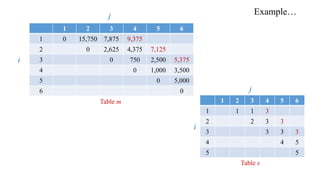
![Example…
• l = 5 → 5 Matrices
• Matrices: A1 A2 A3 A4 A5, A2 A3 A4 A5 A6
• No. of positions where split can occur = 4.
Therefore, k = (1, 2, 3, 4), (2, 3, 4, 5) respectively.
• Number of different parenthesizations:
A1 A2 A3 A4 A5 :
m [1, 1] + m [2, 5] + p0 p1 p5 = 0 + 7175 + 30 x 35 x 20 = 28,125
m [1, 2] + m [3, 5] + p0 p2 p5 = 15750 + 2500 + 30 x 15 x 20 = 27,250
m [1, 3] + m [4, 5] + p0 p3 p5 = 7875 + 1000 + 30 x 5 x 20 = 11,875
m [1, 4] + m [5, 5] + p0 p4 p5 = 9375 + 0 + 35 x 10 x 20 = 16,375
s [1, 5] = 3
A2 A3 A4 A5 A6 :
m [2, 2] + m [3, 6] + p1 p2 p6 = 0 + 5375 + 35 x 15 x 25 = 18,500
m [2, 3] + m [4, 6] + p2 p3 p6 = 2625 + 3500 + 15 x 5 x 25 = 8,000
m [2, 4] + m [5, 6] + p1 p4 p6 = 4375 + 5000 + 35 x 10 x 25 = 18,125
m [2, 5] + m [6, 6] + p1 p5 p6 = 7125 + 0 + 35 x 20 x 25 = 24,625
s [2, 6] = 3
m [1, 5] = min = 11,875
m [2, 6] = min = 8,000](https://image.slidesharecdn.com/matrixchainmultiplication-200422160133/85/Matrix-chain-multiplication-26-320.jpg)
![Example…
n = 6; pi = 30, 35, 15, 5, 10, 20, 25; l = 5 i = 1 to n - l + 1; j = i + l – 1; k = i to j – 1
q = m [i, k] + m [k + 1, j] + pi-1 pk pj
i = 1
j = 1+5-1 = 5
k = 1
q=m[1,1]+m[2,5]+ p0 p1 p5
=0+7125+30x35x20
q = 28,125
k = 2
q=m[1,2]+m[3,5]+ p0 p2 p5
=15750+2500+30x15x20
q = 27,250
k = 3
q=m[1,3]+m[4,5]+ p0 p3 p5
=7875+1000+30x5x20
q = 11,875
k = 4
q=m[1,4]+m[5,5]+ p0 p4 p5
=9375+0+35x10x20
q = 16,375
m [1, 5] = min (28125, 27250, 11875, 16375) = 11,875
s [1, 5] = 3
i = 2
j = 2+5-1 = 6
k = 2
q=m[2,2]+m[3,6]+ p1 p2 p6
=0+5375+35x15x25
q = 18,500
k = 3
q=m[2,3]+m[4,6]+ p2 p3 p6
=2625+3500+15x5x25
q = 8,000
k = 4
q=m[2,4]+m[5,6]+ p1 p4 p6
=4375+5000+35x10x25
q = 18,125
k = 5
q=m[2,5]+m[6,6]+ p1 p5 p6
=7125+0+35x20x25
q = 24,625
m [2, 6] = min (18500, 8000, 18125, 24625) = 8,000
s [2, 6] = 3](https://image.slidesharecdn.com/matrixchainmultiplication-200422160133/85/Matrix-chain-multiplication-27-320.jpg)

![Example…
• l = 6 → 6 Matrices
• Matrices: A1 A2 A3 A4 A5 A6
• No. of positions where split can occur = 5.
Therefore, k = (1, 2, 3, 4, 5).
• Number of different parenthesizations:
A1 A2 A3 A4 A5 :
m [1, 1] + m [2, 6] + p0 p1 p6 = 0 + 8000 + 30 x 35 x 25 = 34,250
m [1, 2] + m [3, 6] + p0 p2 p6 = 15750 + 5375 + 35 x 15 x 25 = 32,375
m [1, 6] = min m [1, 3] + m [4, 6] + p0 p3 p6 = 7875 + 3500 + 30 x 5 x 25 = 15,125 = 15,125
m [1, 4] + m [5, 6] + p0 p4 p6 = 9375 + 5000 + 35 x 10 x 25 = 21,875
m [1, 5] + m [6, 6] + p0 p5 p6 = 11875 + 0 + 35 x 20 x 25 = 26,875
s [1, 6] = 3](https://image.slidesharecdn.com/matrixchainmultiplication-200422160133/85/Matrix-chain-multiplication-29-320.jpg)
![Example…
n = 6; pi = 30, 35, 15, 5, 10, 20, 25; l = 6 i = 1 to n - l + 1; j = i + l – 1; k = i to j – 1
q = m [i, k] + m [k + 1, j] + pi-1 pk pj
i = 1
j = 1+6-1 = 6
k = 1
q = m [1,1] + m [2,6] + p0 p1 p6
= 0+8000+30x35x25= 34,250
k = 2
q = m [1,2] + m [3,6] + p0 p2 p6
=15750+5375+30x15x25= 32,375
k = 3
q = m [1,3] + m [4,6] + p0 p3 p6
=7875+3500+30x5x25= 15,125
k = 4
q = m [1,4] + m [5,6] + p0 p4 p6
=9375+5000+30x10x25= 21,875
k = 5
q = m [1,5] + m [6,6] + p0 p5 p6
=11875+0+30x20x25 = 26,875
m [1, 6] = min (34250, 34250, 15125, 21875, 26875) = 15125
s [1, 6] = 3](https://image.slidesharecdn.com/matrixchainmultiplication-200422160133/85/Matrix-chain-multiplication-30-320.jpg)
![Example…
1 2 3 4 5 6
1 0 15,750 7,875 9,375 11,875 15125
2 0 2,625 4,375 7,125 8,000
3 0 750 2,500 5,375
4 0 1,000 3,500
5 0 5,000
6 0
j
i
Table m 1 2 3 4 5 6
1 1 1 3 3 3
2 2 3 3 3
3 3 3 3
4 4 5
5 5
Table s
j
i
The Minimum number of Scalar
Multiplications to multiply the 6
matrices A1 A2 A3 A4 A5 A6 is:
m [1, 6] = 15,125.
The Optimal split occurs at:
s [1, 6] = 3.](https://image.slidesharecdn.com/matrixchainmultiplication-200422160133/85/Matrix-chain-multiplication-31-320.jpg)
![• Optimal way of computing A 1 . . n is: A 1 . . S [1, n] x A S [1, n] + 1 . . n
• The initial call PRINT-OPTIMAL-PARENS (s, 1, n) prints an optimal
parenthesization of A1, A2, . . . , An
PRINT-OPTIMAL-PARENS (s, i, j)
If (i == j)
Print “A”i
Else Print “(”
PRINT-OPTIMAL-PARENS (s, i, s [i, j])
PRINT-OPTIMAL-PARENS (s, s [i, j] + 1, j )
Print “)”
4. Constructing an Optimal Solution
PRINT-OPTIMAL-PARENS (s, 1, 6)
prints the Parenthesization:
((A1 (A2 A3)) ((A4 A5) A6))](https://image.slidesharecdn.com/matrixchainmultiplication-200422160133/85/Matrix-chain-multiplication-32-320.jpg)


